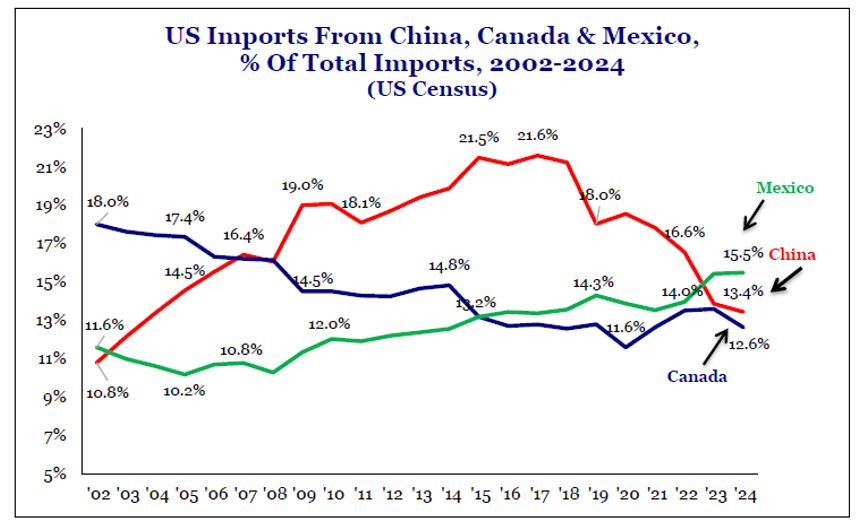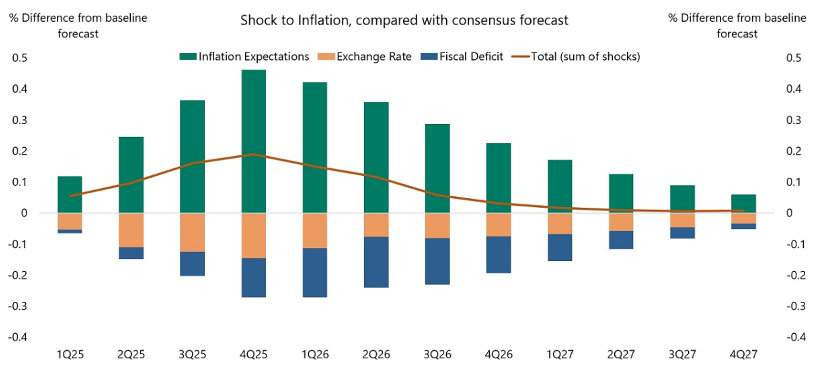Schedule a talk with one of our advisors to learn more about Summitry and how we can help you get a foothold on your financial life. For career opportunities please visit careers at Summitry.
Team
Insights
Pages
- Let's Talk
- Phone / Directions
Tariffs: Keep Calm and Carry On
Mar 30, 2025
Tariff insights from Summitry’s Director of Research & Portfolio Manager, Michael Kon, CFA®
If you turn on the news, you’ll hear about tariffs being discussed day and night as the Trump administration whiplashes between imposing them and canceling or delaying them. The uncertainty of Trump’s policies is weighing on business and consumer confidence, as they could have significant implications for the U.S. economy.
The United States is the world’s largest importer of goods and services at $4.1 trillion. If all the proposed tariffs go into effect and remain in place, Strategas Research Partners estimated their impact on the U.S economy to exceed $230 billion considerably higher than the impact of tariffs announced in the first Trump administration.
“Tariffs by nature are inflationary and tend to lead to higher prices for consumers, but the magnitude and duration of such inflation will depend on many factors,” says Michael Kon, CFA®, Summitry’s Director of Research & Portfolio Manager on Summitry’s recent client investment webinar held on March 13, 2025. Watch the segment on tariffs above.
However, there are other elements to consider, such as productivity improvements and tax cuts, that could potentially offset the negative effects of tariffs, he adds.
What is the Trump administration’s plan on tariffs?
The ultimate goal of using tariffs is to encourage manufacturing onshoring, which is expected to create jobs domestically as more businesses produce in the U.S.
Tariffs can also be used as leverage to pursue broader goals, such as border security, combating the fentanyl crisis, and rebalancing bilateral relationships to reduce U.S. trade deficits.
Time will tell whether the plan will be successful in achieving its objectives.
Tariffs weigh on economic outlook
Going back to basics, the textbook GDP equation consists of key variables that drive economic growth: private consumption, investment, government spending, and net exports (exports minus imports).
When tariffs are introduced, calculating their true impact becomes more complex. More information is needed regarding their duration, magnitude, and the specific circumstances within the impacted industries.

Source: Strategas
Notably, the recent tariffs cover 42% of imports, but most U.S. trade remains unaffected. The current tariffs target key U.S. supply chain partners and could accelerate the onshoring trend that began during supply chain disruptions two years ago following the pandemic. Moreover, they could also reduce dependence on China.
“The U.S. has been decoupling from China for almost seven years now — our imports from China as a percentage of total imports are down from over 20% to the low teens,” says Kon.
What factors could offset the impact of tariffs?
Recent market volatility signals that investors are concerned about a near-term inflation shock and the increasing probability of a recession this year.
However, the consensus view reassures that while tariffs could cause a one-time shock to the economy and inflation, their effects are not expected to be permanent.

Source: Apollo Group
“The other thing to remember is that these [GDP] equations don’t capture other factors such as tax policy, government finances, productivity improvements, and consumer sentiment. These factors could hinder economic growth or contribute to it and offset some of the negative effects of tariffs,” says Kon.
For instance, in 2018, the impact of tariffs was offset by the benefits of the tax cuts. Kon believes productivity gains driven by artificial intelligence, along with potential reductions in government spending, could also counteract inflationary pressures from tariffs.
Tariffs and your investment portfolio
At Summitry, we see economic uncertainty creating periods of market volatility, which could also present investment opportunities. We focus on individual businesses rather than market averages, paying close attention to our companies and their management teams.
Most of our companies developed playbooks when tariffs were a very hot topic in 2018 and 2019. They also have pricing power and can pass tariff costs on to their customers. Many of our businesses operate primarily in local markets unaffected by tariffs and have minimal exposure to international trade flows.
It’s also important to note that the impact of tariffs is geographically uneven, as some states are more exposed to trade with Mexico and Canada than others.
As we navigate these uncertain times, we believe it’s important to stay invested and take a long-term view of your portfolio. Market volatility drives short-term fluctuations, but over the long run, company earnings and valuations will determine returns.
Having a knowledgeable financial advisor to guide your investments and financial planning can give you confidence in achieving a more secure and empowered financial future.
How can Summitry help you?
At Summitry, we help our clients maximize the benefits of life in the Bay Area. As fiduciary advisors, we support our clients with personal financial planning that is always in their best interests. Our unique investment philosophy and customizable portfolios are designed to optimize returns while driving progress toward your personal goals.
Interested in learning more about how we can help set you up for financial success?
Schedule a call to speak with your future financial partner today.
The content in this article is for informational purposes only and does not constitute investment advice. An investor should consult with their financial professional before making any investment decisions. The opinions expressed herein are subject to change at any time without notice.
GET THE NEXT SUMMITRY POST IN YOUR INBOX:
MORE INSIGHTS AND RESOURCES
Let's talk
Schedule a talk with one of our advisors to learn more about Summitry and how we can help you chart a path for your financial future.

Alex Katz
President


